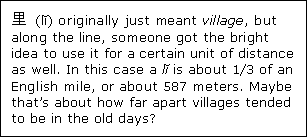Part 4: Construction Principles of Chinese Characters
It starts to get pretty deep here, actually. You might want to take a tea break and a quick stroll around the neighborhood before continuing.
Principle 1 - The Picture Character
Picture characters are simply meant to look like the things they represent. As we mentioned before, though, many pictograms evolved over time so that the resemblance is less than obvious.
NOTE
Chinese characters are often combined to create larger, more complex characters.
This means that learning 2,000 characters in order to be "literate" doesn't mean learning 2,000 unrelated forms. Instead, you will learn a smaller number of basic, independent forms, then move on to more complicated characters that contain more than one basic character.
The example below uses colors to highlight the various "smaller" characters which combine to create the character for "clock."
This means that learning 2,000 characters in order to be "literate" doesn't mean learning 2,000 unrelated forms. Instead, you will learn a smaller number of basic, independent forms, then move on to more complicated characters that contain more than one basic character.
The example below uses colors to highlight the various "smaller" characters which combine to create the character for "clock."
Note that each of these smaller parts already means something else when standing alone.
EXAMPLE
One of my favorites:
This means "tree":木 (mù). Two trees together means "forest": 林 (lín).
A third tree on top means "full of trees": 森 (sēn).
This means "tree":木 (mù). Two trees together means "forest": 林 (lín).
A third tree on top means "full of trees": 森 (sēn).
Symbol characters symbolize (what else!?) an idea or concept. Below, in the character meaning above, the vertical line and small stroke are above the horizontal line. In the character meaning below, they are underneath.
Principle 3 - The Borrowed Sound Character
Also called Sound-Loan characters, these borrow the same written form and sound of another character, but have unrelated meanings.
HUH?
You might compare Sound Loan characters to this bit of silliness:
Slightly Adapted from http://www.chinese-outpost.com





No comments:
Post a Comment